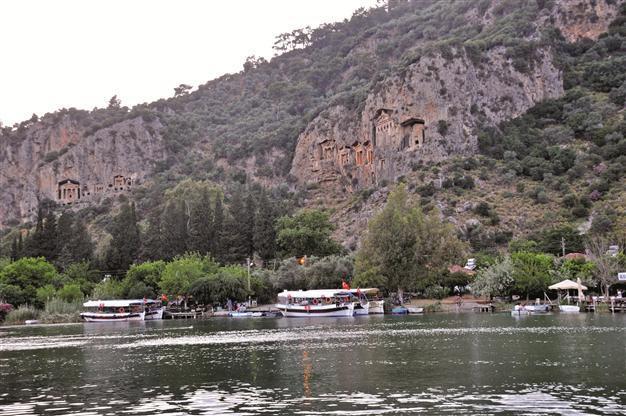Kaunos ancient city attracts more tourists
MUĞLA - Anadolu Agency

Kaunos Ancient city at Dalaman used to have two ports, the southern port at the southeast of Küçük Kale and the inner port at its northwest. The southern port was used from the foundation of the city until roughly the end of Hellenistic era.
The ancient city of Kaunos hosts more tourists each year. The city, which is in Köyceğiz and dates back 3,000 years, attracted 30,000 tourists last year. This year officials expect another increase, said Professor Cengiz Işık, the excavation head. Noting that Kaunos had been an important sea port, Işık said the history of the city is thought to date back to the 10th century B.C.
The city had two ports, the southern port at the southeast of Küçük Kale and the inner port at its northwest. The southern port was used from the foundation of the city until roughly the end of the Hellenistic era, after which it became inaccessible as it dried up. The inner or trade port could be closed by chains. The latter was used till the late days of Kaunos, but due to the silting of the delta and the ports, Kaunos had by then long lost its important function as a trade port.
The latest excavations have revealed the Turkish bath and the walls that surround the city, he added, noting that Kaunos revealed the unknown parts and secrets of Anatolian archaeology. “Kaunos is not a large marble structure like Ephesus. It has a different character and different structure. The ancient city distinguishes itself with its unique character,” he added.
Tombs of KaunosKaunos is surrounded by ancient necropoli, because the ancient Greeks and Romans always buried their dead at considerable distance from their homes. Niche tombs were the most common ones. The ashes of the deceased were put in urns and then placed in a niche. At the port of Çandır, some kilometers from the archaeological site of Kaunos, there are dozens of niche tombs hewn from the rock of Kızıltepe.
Archaeologist Erkan Kart, who participated in the digs in the area, said new excavations in the Ortaca area had revealed a basilica from Roman times, an agora and a temple devoted to Demeter. “The basilica venue in the excavation revealed that there were spaces devoted to shopping, trade and legal institutions in Roman times,” Kart told Anadolu Agency.
Protecting the ancient works“The excavation work includes conservation, restoration and an archaeological park. We will determine the depth of these venues in our continued research,” he added. “On the other hand, the preservation of the rock tombs found in the excavations will begin in September. The nanotechnology-based protection system will be activated in September and will last 10 years.” The rock tombs date back 2,400 years and the team will use nanotechnology to preserve and protect those tombs.
“Apart from the Kaunos excavation work, another big project is waiting for the Turkish archaeology team,” said the archaeologist, adding that the team was working to protect the rock tombs from sunlight and rain.
“We have spoken to the Scientific and Technical Research Council of Turkey [TÜBİTAK], and they have agreed to work with us on this project. We will work on the exclusive protection projection for this issue,” said Kart.
